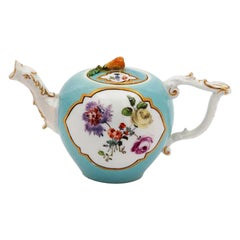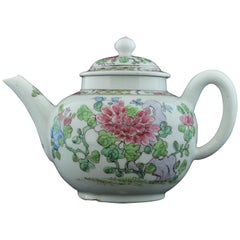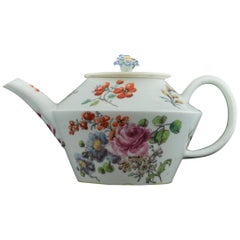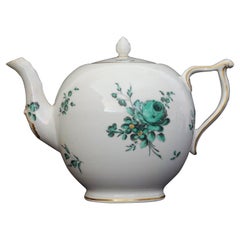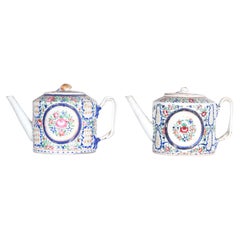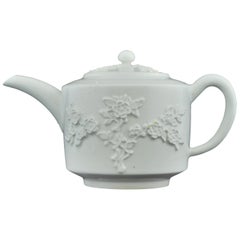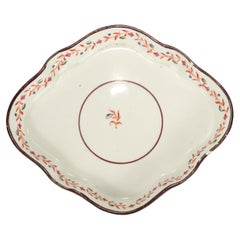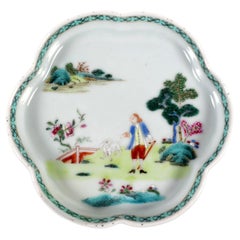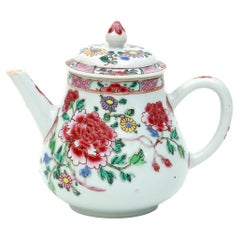18th Century Porcelain Teapots
Antique 1730s German Georgian Porcelain
Porcelain
Antique Mid-18th Century English Chinoiserie Porcelain
Porcelain
Antique Mid-18th Century English Neoclassical Porcelain
Porcelain
Antique Late 18th Century English Neoclassical Porcelain
Porcelain
Antique Late 18th Century Chinese Rococo Porcelain
Porcelain
Antique Mid-18th Century English Chinoiserie Porcelain
Porcelain
Antique 18th Century English Georgian Porcelain
Porcelain
Antique Mid-18th Century Chinese Chinese Export Porcelain
Porcelain
Antique Early 18th Century Chinese Porcelain
Porcelain
Antique 18th Century German Ceramics
Ceramic
Antique Mid-18th Century English Neoclassical Porcelain
Porcelain
Antique Mid-18th Century English Chinoiserie Porcelain
Porcelain
Antique 18th Century Chinese Qing Tea Sets
Porcelain
Antique Mid-18th Century English Chinoiserie Porcelain
Porcelain
Antique Mid-18th Century English Chinoiserie Porcelain
Porcelain
Antique 18th Century Chinese Chinese Export Ceramics
Porcelain
Antique 18th Century Chinese Qing Tea Sets
Porcelain
Antique 18th Century Chinese Chinese Export Ceramics
Silver
Antique 18th Century Chinese Chinese Export Ceramics
Silver
Antique 18th Century Chinese Ceramics
Porcelain
Antique Mid-18th Century Chinese Antiquities
Porcelain
Antique Early 18th Century German Other Tea Sets
Porcelain
Antique 18th Century Chinese Tea Sets
Porcelain
Antique 18th Century Chinese Qing Tea Sets
Porcelain
Antique 17th Century Edo Decorative Dishes and Vide-Poche
Porcelain
Antique 18th Century Chinese Decorative Dishes and Vide-Poche
Porcelain
Antique 17th Century Edo Decorative Dishes and Vide-Poche
Porcelain
Antique 17th Century Edo Decorative Dishes and Vide-Poche
Porcelain
Antique 18th Century Chinese Qing Ceramics
Porcelain
Antique 18th Century Japanese Edo Ceramics
Porcelain
Antique 18th Century Chinese Qing Tea Sets
Porcelain
Antique 18th Century Chinese Qing Ceramics
Porcelain
Antique 18th Century Chinese Tea Sets
Porcelain
Antique Early 18th Century German Rococo Tea Sets
Porcelain
Antique 18th Century Chinese Tea Sets
Porcelain
Antique 18th Century Chinese Tea Sets
Porcelain
Antique 18th Century Chinese Regency Ceramics
Porcelain
Antique 18th Century Chinese Qing Ceramics
Porcelain
Antique 18th Century Chinese Qing Tea Sets
Porcelain
Antique 18th Century Chinese Regency Ceramics
Porcelain
Antique 18th Century Chinese Qing Tea Sets
Porcelain
Antique 18th Century Chinese Planters, Cachepots and Jardinières
Porcelain
Antique 18th Century Japanese Edo Tea Sets
Porcelain
Antique 18th Century Japanese Edo Planters, Cachepots and Jardinières
Porcelain
Antique Mid-18th Century Chinese Chinese Export Sculptures and Carvings
Porcelain
Antique 18th Century British George III Decorative Dishes and Vide-Poche
Porcelain
Antique 18th Century Chinese Tea Sets
Porcelain
Antique 18th Century Chinese Ceramics
Porcelain
Antique Early 18th Century Chinese Chinese Export Ceramics
Porcelain
Antique 1770s German Porcelain
Porcelain
Antique Late 18th Century Chinese Chinese Export Porcelain
Porcelain
Antique Mid-18th Century Chinese Chinese Export Porcelain
Porcelain
Antique 18th Century and Earlier English Porcelain
Porcelain
Antique 18th Century and Earlier English Porcelain
Porcelain
Antique Late 18th Century English Tea Sets
Porcelain
Antique Late 18th Century English Porcelain
Porcelain
Antique 18th Century and Earlier British Porcelain
Porcelain
- 1
18th Century Porcelain Teapots For Sale on 1stDibs
How Much are 18th Century Porcelain Teapots?
- 1stDibs ExpertApril 5, 2022At the end of the 17th century, Europe went into a frenzy over porcelain. Asian porcelain was highly sought after, and spurred the foundation of the Meissen factory in France, where hard porcelain went on to be made. You’ll find a large collection of porcelain pieces from many of the world’s top sellers on 1stDibs.
- 1stDibs ExpertNovember 13, 2024To identify 18th-century furniture, you can research your piece in the context of the prevailing styles of the period or consult a certified appraiser or experienced antique dealer. To identify your item on your own, look over it for maker's marks, such as carvings, stamps, brands and labels. Researching the marking can help you determine the maker of your piece, and from there, you can search further to learn more about your particular item. Without a maker's mark, the best approach is to consider the characteristics of the dominant furniture styles during the 18th century. In England, these included William and Mary, Queen Anne, Georgian, Chippendale, Hepplewhite and Sheraton. Some French furniture styles of the 1700s include Louis XV, Louis XVI and Régence. Find a diverse assortment of 18th-century furniture on 1stDibs.
- 1stDibs ExpertApril 5, 2022Yes, wedding rings have a long history, stretching back to ancient Egypt. The first diamond engagement ring was created in 1477 by Archduke Maximillian of Austria. Browse a wide array of vintage and contemporary wedding rings on 1stDibs.
- 1stDibs ExpertApril 5, 2022In the 18th century, art changed in style from Baroque to Rococo and Neoclassicism. Art became more ornamented and idealized during the Rococo period and then shifted toward a style that emulated the artwork of ancient Greece and Rome near the end of the century. You’ll find a variety of fine art on 1stDibs.
- 1stDibs ExpertApril 5, 2022One way to check if your brass candlesticks are from the 18th century is to look for the two seams running lengthwise on either side. This is from when the candlestick was molded in two halves and then soldered together. You’ll find a variety of candlesticks of all shapes and sizes from some of the top sellers on 1stDibs.
- 1stDibs ExpertJanuary 10, 2025The individuals considered the Big Three of 18th-century cartoons are William Hogarth, James Gillray and George Cruikshank. Although the 18th century saw a widespread increase in illustrations in newspapers, these three illustrators were particularly well-known for their work. Hogarth's work was extremely diverse, ranging from serious, realistic paintings and portraits to satirical and moralistic illustrations filled with symbolism. A British caricaturist, Gillray is remembered today for his artworks representing political and social satires, like his political cartoons against George III of England. Despite being a prolific caricaturist, Cruikshank is now most famous for illustrating the works of Charles Dickens. On 1stDibs, find a wide variety of illustrations.
Read More
How a Craving for Color Revolutionized Glass
After synthetic dyes changed fashion, home goods and printed matter, it was only a matter of time till glass caught up.
1882 Ltd. Looks to the Future of Ceramics in the U.K. with an Eclectic Exhibition and Auction
Faye Toogood and John Pawson are among the list of plate designers.
20 Inviting Dining Rooms Perfectly Arranged for Entertaining
Top interior designers show — and tell — us how to create delectable spaces for hosting dinner parties.
Paul Revere Crafted This Silver Coffee Pot 250 Years Ago
Perhaps best known as a Revolutionary War hero, Revere was also an accomplished silversmith, and this pot is now available on 1stDibs.
From Arne Jacobsen to Zaha Hadid, Top Designers Tackle Tableware
Clever objects like these make feasting even more festive.
How the Chunky, Funky Ceramics of 5 Mid-Century American Artists Balanced Out Slick Modernism
Get to know the innovators behind the pottery countercultural revolution.
Ready for a Cinderella Moment? This Glass Handbag Is a Perfect Fit
Glass slippers might be the stuff of fairytales, but glass handbags? Artist Joshua Raiffe has made them a reality, and they're far less delicate than you might imagine, but just as dreamy.
With Dansk, Jens Quistgaard Delivered Danish Simplicity to American Tables
When a visionary Copenhagen designer teamed up with an enterprising Long Island couple, Scandi-style magic landed in kitchens and dining rooms across the United States.
